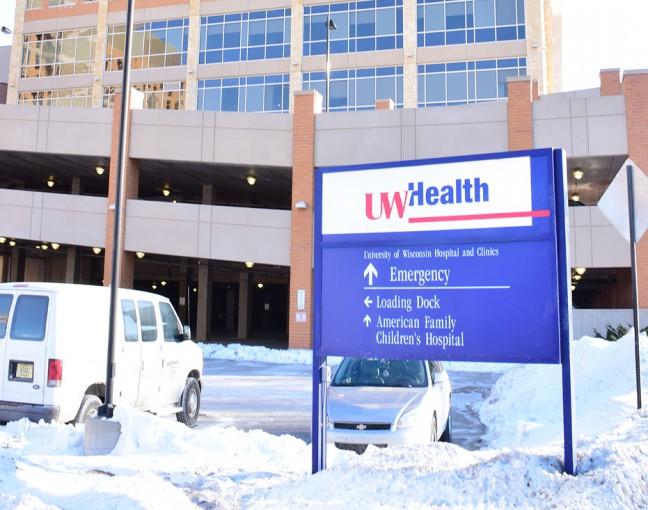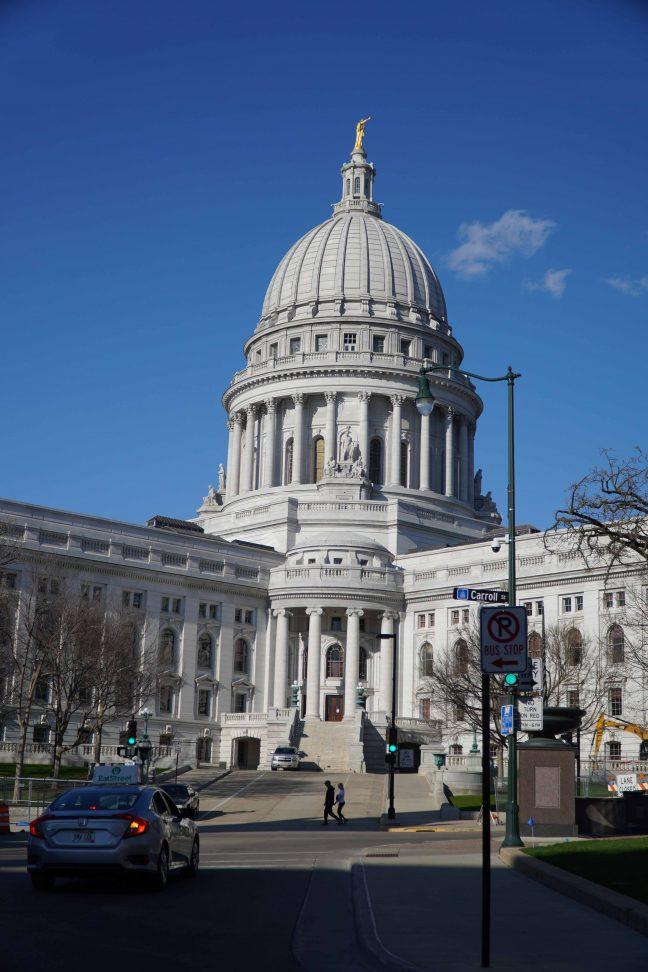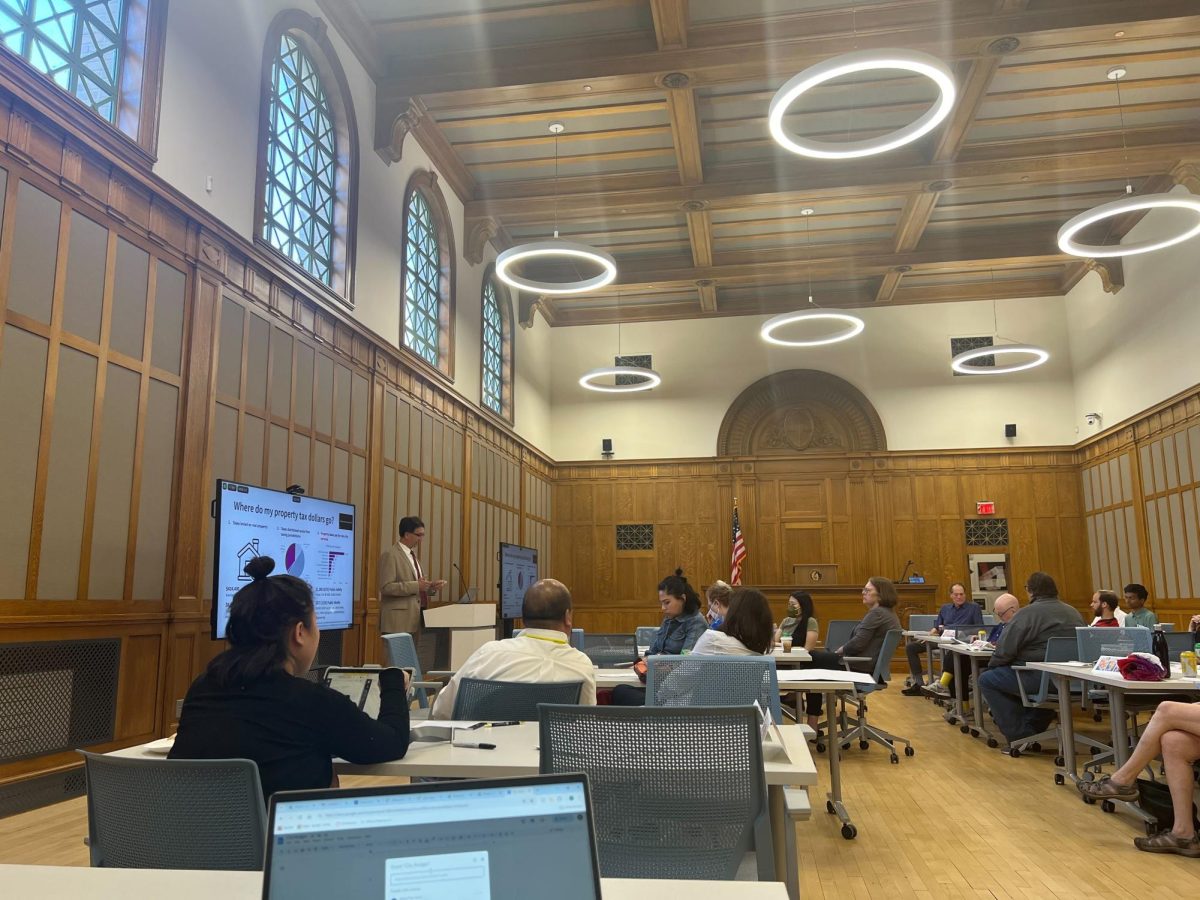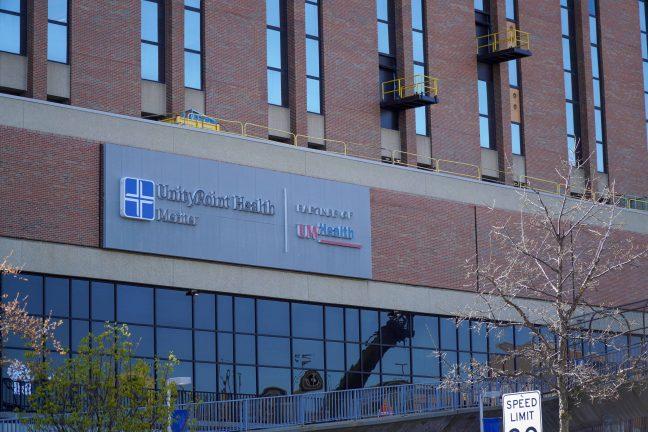Campus
UW professionals help meet hospitals’ PPE need, solve distribution issue
The University of Wisconsin staff stepped up to create Personal Protective Equipment to fulfill shortages and create software to solve PPE distribution issues.
The Zeeh Pharmaceutical Experiment Station team in the UW School of Pharmacy is helping UW Health meet its PPE need by producing hand sanitizer. Director of the Zeeh Pharmaceutical Experiment Station Edmund Elder said the team decided to increase production when they realized UW Hospital needed more sanitizer than what was originally thought.
Unlike the traditional hand sanitizer customers buy from stores, the sanitizer produced by Elder’s lab is a liquid consistency instead of a gel, Elder said. Additionally, the sanitizer has more alcohol in it, which makes it more effective at killing the virus.
UW professionals help meet hospitals’ PPE need, solve distribution issues
“Purell or other brands of commercially available hand sanitizer have 70% alcohol content and those are tested to make sure that they kill bacteria,” Elder said. “We’re dealing with a virus — viruses are more difficult to kill, usually, than bacteria.”
The hand sanitizer, which is based on the World Health Organization’s recommendations, has only four ingredients — alcohol, hydrogen peroxide, glycerol and water, according to Elder.
After it is made, the team packages the sanitizer and delivers it to UW Health. The sanitizer is also provided to on-campus isolation facilities, like the dorms, Elder said.
Another group on campus helping to provide PPE to health care workers in the community is the UW Division of Information Technology’s Digital Publishing and Printing Services. DPPS has Wisconsin’s largest in-house printing operation and are making face shields, DPPS Director Geoff Larson said in a UW news release.
Once the prototype was approved, DPPS began production to fulfill UW Hospital’s order of 12,000 face shields, Larson said. DPPS collaborated with UW Makerspace to give other people secure access to ‘Badger Shields.’
But, once more manufacturers began producing Badger Shields and more hospitals requested them, a distribution problem arose, according to UW Assistant Professor of Industrial and Systems Engineering Justin Boutilier.
“When [Badger Shield] started, manufacturers started picking it up and requesting it, so as the scale — the number of hospitals and the number of manufacturers getting involved—started increasing, manually matching them started to become infeasible because of the size,” Boutilier said.
UW labs collaborate to process thousands of COVID-19 tests, deal with supply shortages
Boutilier worked with biomedical engineering graduate student Rebecca Alcock and University of California, Los Angeles Professor Auyon Siddiq to create “Shield-Net” — a website designed to match PPE manufacturers with hospitals in need.
The website uses an algorithm to make optimized matches based on distance, size and urgency, Boutilier said.
“We try to make it somewhat equitable so that not a single hospital or a single manufacturer gets all of the matches,” Boutilier said. “On the manufacturer side, many of the manufacturers who were producing face shields are able to stay open because of this.”
Both Boutlier and Elder said they are happy to help meet PPE demand at hospitals during this critical time.
Lake Mendota’s late freeze coincides with warming climate induced trends
Data shows the average freeze date for Lake Mendota in January was much later than it usually freezes, according to University of Wisconsin Professor and Director Emeritus of the Center of Limnology John Magnuson.
Lake Mendota officially froze Jan. 12 this year, according to UW’s Center for Limnology — three weeks later than average. In the 1850s, when freezing data for the lake was first recorded, ice covered the lake for an average of five months, compared to only four months in recent years, Magnuson said.
Lake Mendota’s late freeze coincides with warming climate induced trends
Over the 150 years of data, Lake Mendota froze as late as January only 25 times, and ten of those occurrences are in the last 20 years, according to UW’s Center for Limnology.
“The reason it’s freezing later is those really bitter cold nights are not occurring as early in the winter,” Magnuson said. “But the main crux of this, the reason we are in this situation, is because our climate is warming.”
Magnuson said the loss of ice-on time on the lake could affect the seasons of the water. Lakes have winter seasons, where the water is predominately cold, and summer, where water is warm, with fall and spring having a mix.
If this trend continues, Magnuson said the wintertime is lost and the lake is cut down to two seasons, which could impact the ecosystem. This leads to the lake’s climate disrupting the life cycle of cold-water fish and favoring warm-water fish.
Magnuson predicts the lake will have its first year without full ice cover in the next 30 years. In the years that follow, Magnuson said the proportion of years without full ice cover will slowly increase, which brings into question the safety of being on the ice.
“As you go farther down that period, it’s more difficult to predict whether the ice is safe, and it is not likely that the ice is as thick,” Magnuson said. “We end up having to be more aware of how we interact with the lake if we want to be safe, even on the ice years.”
Magnuson said 14,800 lakes experience intermittent winter ice cover in the Northern Hemisphere currently, which means they do not freeze over completely. That number could double if the climate warms 2°C and could reach as high as 230,400 lakes if the climate rises 8°C, Magnuson said.
Right now, the planet is expected to warm 8°C with little or no climate change mitigation, Magnuson said, while the goal of the Paris Accords is to have the average temperature rise only 2°C.
“Ice on and off dates are very easy for people to relate to. They are based on direct observation,” Magnuson said. “I think one of the most important things that people don’t realize is that the duration of ice, when it freezes and when it breaks, has a lot of consequences important to people.”
City
City officials, experts strive to provide resources to aid struggling businesses
Madison’s vibrant small business community braced for economic impact while city officials and experts scrambled to provide answers and resources to business owners during the COVID-19 pandemic.
In Madison, many local businesses started to feel the economic pressure when Gov. Tony Evers’ Safer at Home restrictions went into effect. Marketing Director of Madison’s Ian’s Pizza Zachary Chapman said the popular pizza chain faced economic fallout in all three of its Madison locations.
Chapman said the hardest hit location was North Frances Street, which predominantly relies on the University of Wisconsin student population for business. The student population’s absence — combined with the closing of many bars — eliminated the night crowd. As a result, Ian’s Pizza must face new staffing and survival questions on a daily basis, Chapman said.
City officials, experts strive to provide resources to aid struggling businesses
While Congress passed some COVID-19 relief packages and Wisconsin had average funds to gain its footing in the economic fallout, Business Development Specialist for the Madison Economic Development Division Ruth Rohlich said the state and local governments were trying to find creative ways to get business owners the immediate relief they need.
Rohlich said in light of Madison’s “dramatic and painful losses” in just the first few weeks of the pandemic, the city worked to provide access to resources and loans that can be dispensed quicker than state or federal aid. Through putting together information channels and access to emergency relief aid through zero interest loan options, Rohlich said local officials are striving to lessen the blow of COVID-19 on Madison’s business community.
Looking to the future, UW Economics Professor and Director for the Center of Research on the Wisconsin Economy Noah Williams said the total revenue for some restaurants and other businesses was down by over 90% since the start of the pandemic. Though, Williams said if restaurants suspended operations with ample aid provided, they should ideally be able to restart when restrictions are lifted given the state of the economy before COVID-19.
Williams said one key building block to restart the economy is dealing with unemployment issues. If laid-off workers receive assistance now, Williams said the ability to restart the economy will be easier once the businesses can start opening.
Blank releases employee furlough policy to make up for COVID-19 financial losses
Whether payments are taxable or universal, Williams said people making unemployment claims need options for the time being to provide immediate temporary relief, and the temporal income will help stimulate the economy through the crisis.
StartingBlock Madison Director Chandra Miller Fienen said current startups and new small businesses looking for support during the COVID-19 pandemic could be key in providing much needed employment options in the future.
While much of the aid is being put towards brick-and-mortar local businesses and the hospitality sector, Miller Fienen said businesses less than five years old are responsible for all new net job creation, making them an important component of rebuilding the economy.
Chapman and Rohlich both emphasized the importance of supporting small businesses during this time. Ian’s has served Madison for 19 years — Chapman said service will not stop now despite the challenges of the pandemic.
Wisconsin racial disparities persist, city, local activists work to alleviate gaps in Madison
State and city officials and activists continue to work to close racial disparity gaps in Dane County.
Wisconsin ranks first in the country in racial disparities according to a report by job resource site Zippia. Various organizations around Dane County and the local government are working together to improve racial disparities in the community.
President of the Dane County NAACP Greg Jones worked to create equal opportunities for minority communities in Dane County. Jones said placing minority community issues at the forefront of government reform in next year’s election is a priority.
Wisconsin racial disparities persist, city, local activists work to alleviate gaps in Madison
“We tend to follow our national guidelines as far as the game-changer areas of focus,” Jones said. “But at the same time, we know that each community has some unique issues that it faces.”
Jones said in Dane County, issues with the highest priority are education, criminal justice, health and economic and job development. While most of these issues are typical across the nation, Jones said Madison has some unique issues.
In Madison, educational achievements among young minorities is a major issue the NAACP is striving to fix.
“Not just the disparities in terms of the academic gap, reading and language … but also the education outcome for graduation,” Jones said. “You have a growing number of people of color who are not getting to that level. Those things are systematic and need to be looked at.”
Specifically, the NAACP is working with school districts to work out how they can advocate for youths who are facing the achievement gap. The issue with educational achievement gaps is they can lead to other achievement gaps, leaving students in a poverty pusher, Jones said.
Director of Civil Rights Norman Davis said the city became much more active in recent years in helping combat racial disparities.
Dane County books hotel rooms to ensure safe social distancing for homeless
“The city has participated in discrimination in some way, shape or form, whether actively or passively,” Davis said. “We wanted to make sure that we stand any future opportunities so that the city would incorporate racial equity strategies with all the plans and policies and the decisions that we’re making.”
According to Davis, the city is prioritizing the impacts of the Madison housing crisis. The Equal Opportunities Commission is playing a large role in the government’s efforts by listening to stories from members of the Madison community, Davis said.
“[We] are very focused on making sure that our communities of color and other marginalized groups have a strong sense of belonging as residents here in Madison,” Davis said.
State
Legislators work to develop new, smaller facilities for juveniles
Despite the Department of Corrections’ attempts to change the culture, Wisconsin youth prisons had an increase in staff and youth assaults in the last year.
According to a report requested by 27 News to the Department of Corrections, from 2018-2019, youth-on-youth assaults at Lincoln Hills and Copper Lake increased from 118 to 165, and youth-on-staff assaults increased from 109 to 162.
Rep. Evan Goyke, D-Milwaukee, said after a special court monitor was issued there was a reduction in the use of restraints, pepper spray and solitary confinement, but those conditions are not eliminated.
Legislators work to develop new, smaller facilities for juveniles
Goyke said Act 185 passed in 2017 to close Lincoln Hills and Copper Lake by 2021. But, it is unlikely right now that Lincoln Hills and Copper Lake will close, as there is not a viable alternative in the form of more expanded local facilities.
According to 27 News, a survey from October found 44% of inmates feared for their safety, and 48% felt they were threatened or were beat up in the last six months.
Sen. Lena Taylor, D-Milwaukee, discussed the potential causes for the juvenile assaults at Copper Lake and Lincoln Hills.
“I believe part of the reason is because we see juvenile corrections as a mini adult system and it’s not,” Taylor said. “How we treat juveniles should be profoundly different than how we treat adults, and we have not fully embraced that as a state under the present majority.”
Co-founder of Youth Justice Milwaukee Sharlen Moore said YJM is advocating for the new facilities to be smaller, home-like facilities with four to 10 beds.
Taylor agreed, but said opening these facilities will be difficult because they are underfunded by nearly $10 million. Goyke said he is not aware of any plans for the model Moore is pushing for.
Taylor said she would like if the new facilities do not resemble a prison as much as they presently do. She added the new facilities should have improved staffing ratios and ways to help strengthen young peoples’ families.
In the October survey, 79% of staff who participated said they feared for their safety, and 83% felt the facilities were unsafe or dangerous.
Taylor said the DOC is inadequately funded, which leads to a shortage in overall staffing of correctional officers. There is a shortage in other staff as well, such as teachers, health practitioners and psychologists, Moore added.
Moore said YJM’s goals are to close Lincoln Hills and Copper Lake as well as to remove the jurisdiction of youth from the DOC and place it under the jurisdiction of the Department of Children and Families. Moore added YJM aims to get rid of the serious juvenile offender distinction.
Goyke spoke on the importance of these facilities, particularly in regards to the youth’s future. Goyke said the whole point of this is to reduce recidivism and to ensure to do the best so youths do not come back.
“The true issue here is that we have to invest in our children, they’re our future,” Taylor said. “It’s getting to the root of the harm that was caused to them, getting some healing for them as well as accountability for the harm that they have caused to others.”
Farm workers are at increased risk for coronavirus
The current work environment for many of Wisconsin’s farm laborers puts them at an increased risk of contracting COVID-19.
According to Johns Hopkins Center for Health and Security Medical Anthropologist Monica Schoch-Spana, agricultural workers are at an increased risk of developing medical conditions such as diabetes and asthma — both of which are tied to increased risk of hospitalization from COVID-19 — from exposure to pesticides. Schoch-Spana said many farm workers are unable to obtain health insurance and are unable to cover the cost of medical expenditures.
The nature of farm laborers’ work, which places them in close proximity to one another in the fields and living in high-density lodging, leads to an ecosystem which makes social distancing nearly impossible, Schoch-Spana said.
Migrant farmworkers, in particular, face a unique set of challenges. Centro de los Derechos del Migrante’s Spokeswoman María Perales Sanchez said migrant workers, both documented and undocumented, who make up roughly 72% of the United States’ farm labor force, often fear retaliation from the federal government if they seek medical attention. Perales Sanchez said many migrant workers feel as though they cannot afford to take time off from work, which may force them to avoid treatment altogether.
“One thing that we do see for migrant workers is that they depend on their job to be able to feed their families, to make it day by day, and so even if they are feeling ill sometimes, it’s difficult for them to make that choice,” Sanchez said.
Congressional Relations Director of the American Farm Bureau Federation Allison Crittenden said a variety of measures were taken to reduce the risks of contracting COVID-19 posed to farm workers, including legislation which provides sick leave for laborers who contract COVID-19.
Crittenden said several farms are distributing personal protective equipment to employees in addition to establishing cleaning schedules for their work spaces. According to Crittenden, the Farm Bureau is working to offset the cost of these extra sanitation measures implemented by farmers.
To address health outcome disparities faced by fearful migrant workers, Immigration and Customs Enforcement announced they will not arrest undocumented immigrants who seek medical attention for the duration of the COVID-19 pandemic, and Citizenship and Immigration Services said they will not penalize immigrants who require testing, should they apply for visas or green cards in the future.
Crittenden said the safety of laborers remains a top priority of the Farm Bureau, but Schoch-Spana said structural changes to housing, wages and immigration policy are necessary to protect farm workers in her view.
“Lower income workforces keep our communities functioning and getting food from the field to the grocery stores is absolutely essential,” Schoch-Spana said. “They are essential workers and yet they are devalued and their health suffers for it.”
























